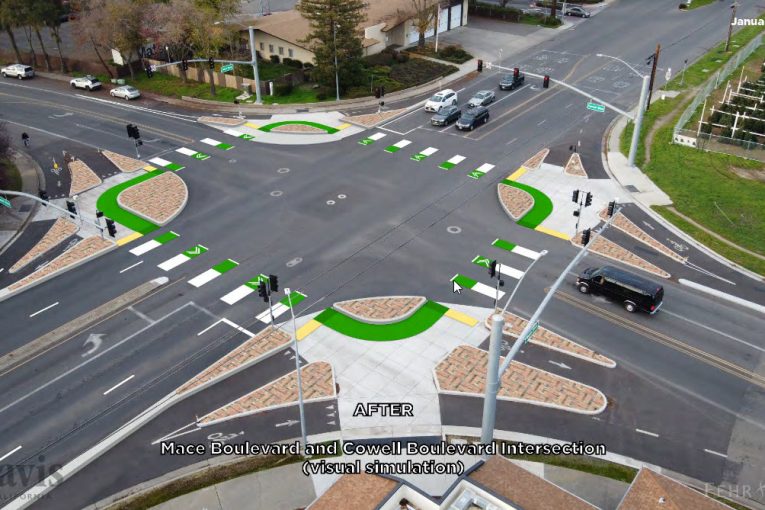

By David M. Greenwald
Executive Editor
At a community meeting on Thursday, the city presented a newly-configured plan for Mace Blvd., south of Chiles. The plan restores the road to four vehicle lanes after a reconfiguration a few years ago reduced the number of vehicle travel lanes and drew outrage from residents along Mace who complained when traffic back ups occurred during peak times—especially on Thursday and Friday evenings.
“With the proposed design modifications we attempt to balance the needs of all corridor users to the best of our ability,” City Manager Mike Webb told the Vanguard.
There has been a good deal of conversation with all stakeholders,” Mayor Gloria Partida added. “I am grateful to the county for participating. There are many competing interest as well as the challenge of adjusting to change. The bottom line is ensuring safety for young riders. There are still some adjustments I have questions about but in general I think the modifications address many of the concerns.”
The problems emerged as a confluence of events happened in close proximity—the road redesign, traffic congestions along I-80 increasing, and directional apps like Waze re-routing traffic onto Tremont (bypassing I-80 and leading people back onto the freeway at Mace, causing, at times, huge congestion).
The city started meeting with concerned residents and the county in 2019, but, with the pandemic, progress has been slow.
“After we had our last whole council discussion (Sept/Oct 2019), I had certainly anticipated it moving forward soon thereafter, but no one would have foreseen the pandemic and the delays caused by it. Unfortunately, that is time that we can’t get back,” Vice Mayor Frerichs said.
He added, “The city has been holding meetings (Josh Chapman & I, plus key staff & consultants) with the county (Sup. Provenza and county staff) for at least the last 6-8 months, and we have been diligently working on addressing a variety of the key items consistently raised by users of the corridor.”
The proposal still has to go back to the council for approval.
The redesigns are aimed to balance the need for traffic throughout with the need for multimodal transportation.
“Vehicles, buses, trucks, ag equipment, emergency vehicles, cyclists, and pedestrians. While not necessarily perfect for any one user, the updated design gets closer to achieving this balance for safe operation of the corridor,” Webb said.
They are looking to:
- Reduce the delay for residents along the corridor
- Accommodate people riding bicycles of all ages and abilities
- Discourage rerouting of freeway traffic with navigation applications
- Accommodate emergency response and farm vehicles
To do that they will add two north and southbound traffic lanes between Cowell and North El Macero Drive. They will have a one-way, protected bike lane and will modify the median for the benefit of both public safety and farm vehicles.
This includes reducing the width of the median and adding some additional landscaping.
They will also make modifications to the striping between San Marino and North El Macero “to accommodate two northbound travel lanes along the full length of the roadway while maintaining the bike buffers.”
They will also make “modifications to the protected intersection at Cowell/Mace, including accommodation for truck-turning radii and modifications to the signal timing and operations.”
As a second phase, they will install a pilot project metering traffic light simulation at Tremont and Mace and 30 days later at Montgomery and Mace.
According to them, “City will pay the costs. City and county will each independently determine whether or not to commit to a permanent project based upon factors such as traffic improvement, impact of the signal on residents and businesses and any unintended consequences.”
“For the Mace corridor, the integration of a signal to meter the flow of vehicles before they enter the corridor is crucial to eliminating cut-through traffic trying to skirt I-80,” Mike Webb explained. “The traffic modeling suggests metering is key. The current plans integrate pilot metering signals at two locations, Tremont and Montgomery, so we can test this in the real world before investing in a full permanent signal.”
Finally, they will add two northbound lanes from Redbud to San Marino, after the determination of a successful traffic light pilot.
How much of the traffic concerns this redesign will actually solve remains to be seen.
Mike Webb pointed out, “Traffic congestion is a much bigger picture transportation system issue, far broader than Mace. Ultimately it requires a fix to I-80.”
During the summer, it was announced that the United States Department of Transportation has awarded an $85.9 million Infrastructure for Rebuilding America (INFRA) Grant to the Yolo County Transportation District and the California Department of Transportation’s (Caltrans) District 3 application to improve and expand 17 miles of the Interstate 80 and U.S. Highway 50 corridors in Yolo and Sacramento Counties.
That will allow for freeway expansion and the addition of an HOV (high occupancy vehicle) lane that policeymakers hope will alleviate some of the freeway congestion.
Webb said, “Thankfully the recent INFRA grant award will allow Caltrans to address this.”
He added, “We greatly appreciate the community’s patience as we have worked through these design updates. We appreciate the feedback from stakeholders and will be reviewing that for possible further adjustments before we bring our recommendations to the BTSSC [Bicycling, Transportation and Street Safety Commission] and then City Council. We look forward to continuing forward progress.”
“I think the proposed suite of adjustments will be positive overall,” Vice Mayor Frerichs said. “As I mentioned at the workshop the other night, context also matters—it is important to keep in mind that the peak hour impacts on Mace is one symptom of the larger issues with I-80, which is why I’ve also been focused/working on regional improvements to the entire 80 corridor through Davis and Yolo County.”

